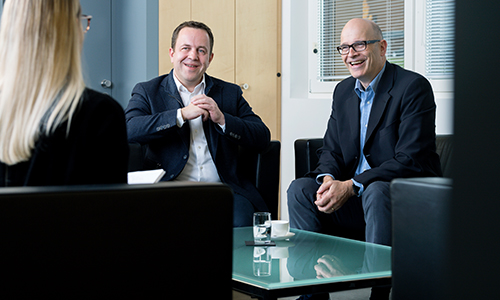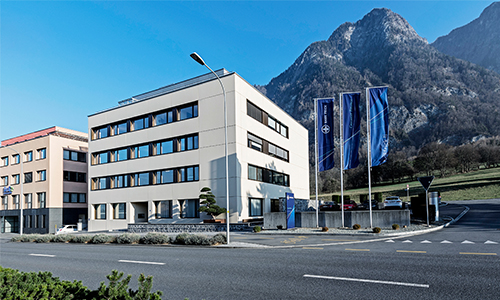Bank Frick is celebrating its 20th anniversary. Chairman of the Board of Directors Mario Frick and CEO Edi Wögerer look back at two decades of entrepreneurial banking.gar
They explain why a company’s vision cannot simply be tokenism, how they generate added value for financial intermediaries, and why blockchain no longer has to be like the Wild West.

Bank Frick CEO, Edi Wögerer (left), and Chairman of the Board of Directors of Bank Frick, Mario Frick: “We quickly tackle projects without them having to pass through seven hierarchical levels, leaving them watered down beyond recognition.”
In the industry, Bank Frick is seen as Europe’s leading bank when it comes to blockchain technology, yet you are somewhat displeased when blockchain is all that people associate Bank Frick with. Why is this?
Edi Wögerer: Because we are so much more than just a blockchain bank. We are a successful custodian bank for funds, and our Funds and Issues department supports our clients with bespoke products for raising equity and debt capital. We are extremely strong in the area of payment processing. We are also the only bank in Liechtenstein with so-called acquiring licences from Mastercard and Visa, for both payment service providers and their affiliated shops. We also offer a full range of traditional banking services, which enable our clients to benefit from practical one-stop banking. So you can see why we’re a little displeased with this reputation [laughs].
We quickly tackle projects without them having to pass through seven hierarchical levels, leaving them watered down beyond recognition.”
Bank Frick sees itself that it is an intermediary bank. Why do you focus on intermediaries instead of dealing directly with end clients?
 Mario Frick: As is the case for all other banks in Liechtenstein, we have been seen as a “private bank” in the past, but in reality, we have always been an intermediary bank. It goes without saying that we have always wanted to attract as many good clients as possible; however, we did not do this via our own advertising or sales channels, but by focusing on cooperation with other financial intermediaries. Thus, the founders of Bank Frick in 1998 included various companies from the financial sector.
Mario Frick: As is the case for all other banks in Liechtenstein, we have been seen as a “private bank” in the past, but in reality, we have always been an intermediary bank. It goes without saying that we have always wanted to attract as many good clients as possible; however, we did not do this via our own advertising or sales channels, but by focusing on cooperation with other financial intermediaries. Thus, the founders of Bank Frick in 1998 included various companies from the financial sector.
And so we provided financial services for other financial intermediaries, such as trust companies, insurers or asset managers, which then further refined these services for their clients. A year ago, we sharpened our vision and mission by underlining that our aim is to support financial intermediaries in successfully differentiating themselves from their competitors. This was all brought together into our strategy, which succinctly summarises our vision, mission and guiding principle.
 Edi Wögerer: I would like to mention that we were recently visited by some external experts, who studied our strategy paper with great interest. According to them, it is extremely rare for a bank to formulate such a clear mission. We don’t see this as mere tokenism, but as a clear strategic direction. Our strategy permeates the entire Bank, and all our employees – including Mario Frick and myself – have to look at our activities and projects to check whether they contribute towards our strategy. If they don’t, then we will discontinue them.
Edi Wögerer: I would like to mention that we were recently visited by some external experts, who studied our strategy paper with great interest. According to them, it is extremely rare for a bank to formulate such a clear mission. We don’t see this as mere tokenism, but as a clear strategic direction. Our strategy permeates the entire Bank, and all our employees – including Mario Frick and myself – have to look at our activities and projects to check whether they contribute towards our strategy. If they don’t, then we will discontinue them.
A recognised provider of modular digital banking services for intermediaries
Why did you go to the trouble of defining a vision and mission for the Bank?
Mario Frick: We are an extremely entrepreneurial bank and tend to quickly tackle projects without them having to pass through seven hierarchical levels, leaving them watered down beyond recognition. This makes us extremely fast. One disadvantage of this, however, is that sometimes we can get up and running too quickly and then only later realise that we are heading in the wrong direction. By having a clear vision in which we position ourselves as a recognised provider of modular digital banking services for intermediaries, we can quickly ascertain whether a business idea is merely opportunistic or whether it is in line with our strategy.
Even though Bank Frick is much more than blockchain, we have to return to this topic. After all, you are known in the industry for being “the” blockchain bank. How did you get this reputation?
Read more on this topic here and find out how Bank Frick enables financial intermediaries to differentiate themselves from their competitors in the market. We’ve also got the low-down on why Mario Frick faced political opposition from some quarters when the Bank was founded and why Edi Wögerer was once banished to the basement.
Bank Frick was founded in 1998 as a four-person operation in Balzers, Liechtenstein. In 2007, the Bank moved into its new headquarters. The building has been too small for the currently 125 employees of the Bank for some time now, meaning it was necessary to rent office space in the immediate vicinity.
The post Europe’s Blockchain Intermediary Bank: “Why Blockchain no longer has to be like the Wild West” appeared first on Fintech Schweiz Digital Finance News - FintechNewsCH.

Comments